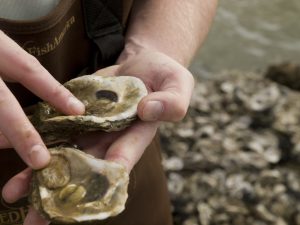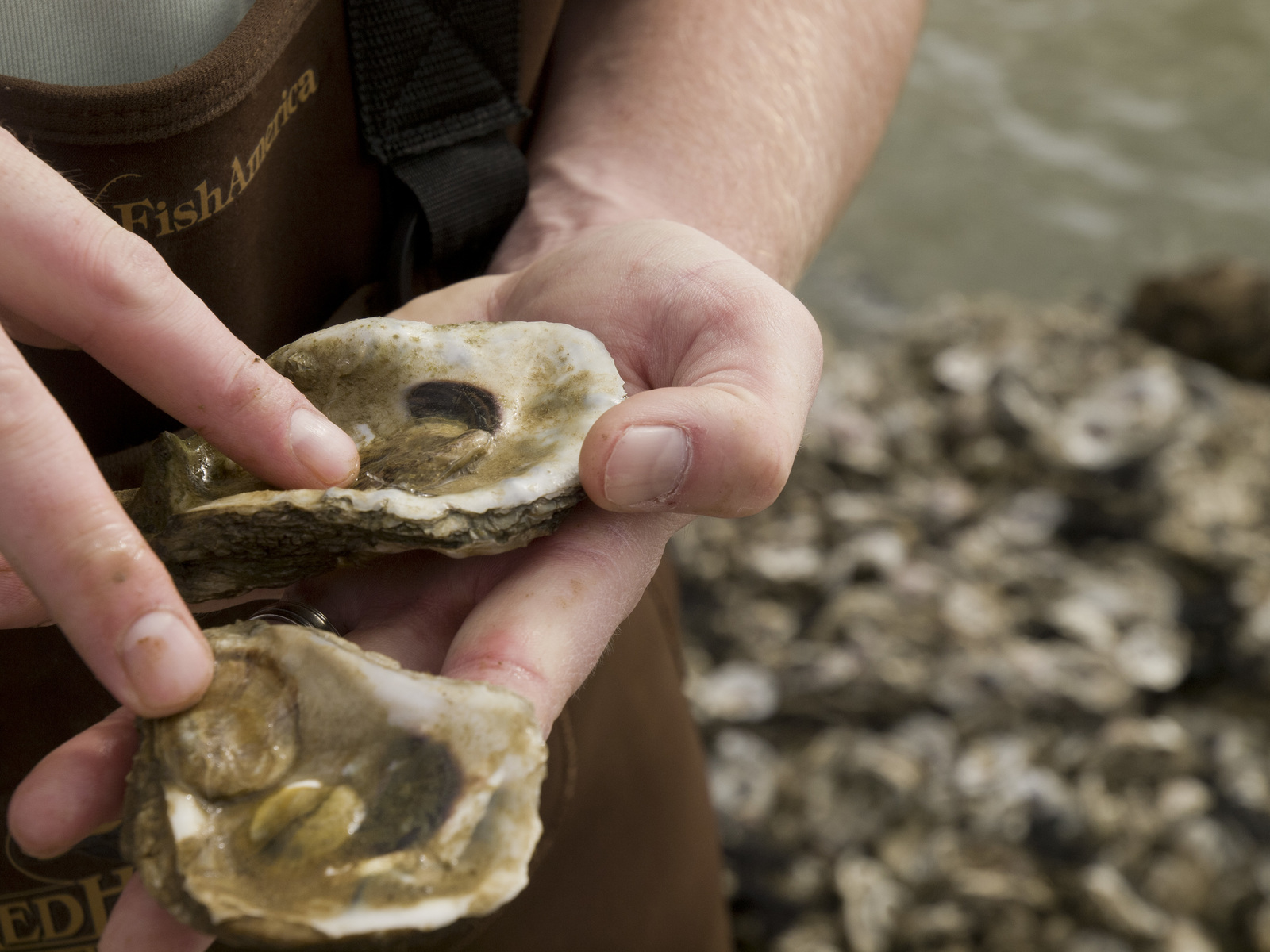Oyster Reefs: How Much Is Enough?
[et_pb_section admin_label=”section”][et_pb_row admin_label=”row” make_fullwidth=”off” use_custom_width=”off” width_unit=”on” use_custom_gutter=”off” padding_mobile=”off” allow_player_pause=”off” parallax=”off” parallax_method=”off” make_equal=”off” parallax_1=”off” parallax_method_1=”off” column_padding_mobile=”on”][et_pb_column type=”4_4″][et_pb_text admin_label=”Main Content” background_layout=”light” text_orientation=”left” use_border_color=”off” border_color=”#ffffff” border_style=”solid”]
Contributed by Bryan DeAngelis
 Oysters are amazing. If you’re like me, and love the cold, salty taste of fresh oysters, know that our desire to consume them is not new. Oysters were a dietary staple for Native Americans and then for early European settlers, who described the abundance of oysters along North America’s coasts as navigational hazards. At first, oysters were easy to collect from shallow coastal waters. But as harvesting increased, hand harvesting gave way to boats and mechanical dredging in more remote locations. Today, over-harvesting is the primary reason oyster reefs are now the most imperiled marine habitat on Earth; some 85 percent have disappeared over the past two centuries.
Oysters are amazing. If you’re like me, and love the cold, salty taste of fresh oysters, know that our desire to consume them is not new. Oysters were a dietary staple for Native Americans and then for early European settlers, who described the abundance of oysters along North America’s coasts as navigational hazards. At first, oysters were easy to collect from shallow coastal waters. But as harvesting increased, hand harvesting gave way to boats and mechanical dredging in more remote locations. Today, over-harvesting is the primary reason oyster reefs are now the most imperiled marine habitat on Earth; some 85 percent have disappeared over the past two centuries.
But it’s not their taste that makes me say oysters are amazing. It’s what they do for our coasts and estuaries—and ultimately people—that makes them amazing. Oysters grow together, and collectively, they form reefs, which serve as critical habitat. Historically, oyster reefs played a major role in the function and health of our coastal bays and estuaries. First, oysters—as they feed—act as water filtering machines that improve water quality and clarity, which promotes the growth of seagrasses that also serve as an important habitat type. And if you like fish—whether catching or eating them—oyster reefs provide essential habitat for fish to feed and grow.
 Researchers at Matagorda Bay conducted extensive studies before efforts to restore oysters began in 2013. Their research captured baseline data that now enables the researchers to determine the impacts of the restoration projects, including effects on other species, like fish and crabs. Photo © Jerod Foster for The Nature Conservancy
Researchers at Matagorda Bay conducted extensive studies before efforts to restore oysters began in 2013. Their research captured baseline data that now enables the researchers to determine the impacts of the restoration projects, including effects on other species, like fish and crabs. Photo © Jerod Foster for The Nature Conservancy
It’s for these reasons that The Nature Conservancy is working to restore oysters. Working alongside partners and nearly 20,000 volunteers, we’ve helped reestablish oyster reefs along the Gulf of Mexico, the Atlantic Ocean and the Pacific Ocean with the aim of restoring the benefits, or ecosystem services, they provide for people and nature.
The online oyster calculator
When restoring oyster reefs to get cleaner water, more fish or any other benefits they provide, it begs the question, “How much is enough?” Until recently, we couldn’t provide answers based on clear-cut science if, for example, leaders of a bayside community who wanted more fish asked, “How many oysters do we need?”
Now we can start to answer such questions. In 2010, the Conservancy began working with the National Oceanic and Atmospheric Administration (NOAA), the National Fish and Wildlife Foundation, and a large group of shellfish, marine and fisheries scientists, to develop the science and tools to determine how many oysters would be needed to filter water in a given estuary or bay or how many are needed to produce a desired increase in fish. Of course, figuring this out requires a lot of math that involves a lot of different input and parameters, which is why one of the tools we produced was an online oyster calculator that makes it easier on those who are planning or implementing restoration projects.
The partners also recently published an accompanying Manager’s Guide to assist natural resource managers and restoration practitioners in making the case for oyster restoration and in setting quantitative objectives for restoring oyster reefs at an estuary, or bay-wide scale.
Oyster calculator: real-world applications
Matagorda Bay in Texas was once home to over 40,000 acres of oyster reefs—more than enough to fully filter all the water in the bay. Today, only a fraction of that habitat remains. The Conservancy and its partners began plans and preparations to restore oysters at Half Moon Reef in Matagorda Bay in 2006. Construction began in 2013. Since then, the partners have restored more than 54 acres of oyster reef habitat at Half Moon Reef, and have monitored the results closely.
[su_youtube url=”https://www.youtube.com/watch?v=PIZKkfozpj0″ width=”400″ height=”200″]
Using data from the last monitoring at Half Moon Reef, the Manager’s Guide and online calculator to compute water filtration provided by this project, the restored reefs now filter 12.4 million liters of water per hour, or 7 percent of Matagorda Bay during the summer months. So when setting objectives for oyster reef restoration here, aiming for the full filtration of the estuary may be a suitable long-term goal.
Calculators for other habitats?
The initial interest in the oyster calculator and Manager’s Guide and its potential to help set achievable objectives for oyster reef restoration have spawned the question, “Can we create similar tools for other habitat types that provide valuable ecosystem services?”
Our answer—yes. The Conservancy is working with NOAA to do just that for salt marshes and seagrass, which can help improve water quality, protect shorelines and provide critical habitat for wildlife, including fish, shrimp and crabs as well as shorebirds and land animals.
[/et_pb_text][et_pb_text admin_label=”For more on this subject:” background_layout=”light” text_orientation=”left” use_border_color=”off” border_color=”#ffffff” border_style=”solid” custom_css_main_element=”border-top: 1px black solid;||padding-top: 25px;”]
For more on this subject:
Visit the Oyster Restoration Goal Setting Online Calculator
Download and Read the Oyster Restoration Goal Setting Manager’s Guide
[/et_pb_text][et_pb_text admin_label=”foot notes” background_layout=”light” text_orientation=”left” use_border_color=”off” border_color=”#ffffff” border_style=”solid” custom_css_main_element=”border-top: 1px black solid;||padding-top: 25px;”]
The original version of this post appeared on TreeHugger.com.
[/et_pb_text][/et_pb_column][/et_pb_row][/et_pb_section]


